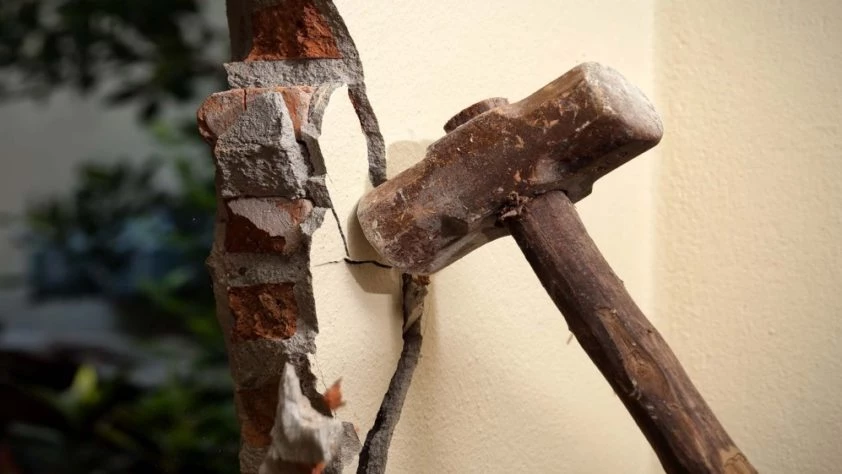
Frequently Asked Questions- Hacking
1.What is purpose of hacking in the concrete?
Concrete Hacking is a process of making smooth surface rough. It makes on surface of concrete to provide a strong bond for plastering. As the finishing surface of concrete is smooth, plaster wont sticks to it. To create a strong mechanical bonding between them, this process of hacking in concrete performs.
2.What is Hacking (of concrete) in construction.
Hacking refers striking of surfaces such as RCC walls, columns, beams, slabs etc., with a chisel to dent the surface in order to create a proper mechanical bond with cement mortar/gypsum plaster directly applied on it.
3.Why Hacking is important?
Since concrete finished surface is smooth, plastering materials would not bond with such surfaces. Dents created by hacking concrete surfaces will help in mechanical bonding of plasters (cement mortar & gypsum plaster)
4.What is hacking in plaster?
Before cement plastering is done, concrete slabs (soffits or ceilings), walls, columns, and beams are hacked with a chisel and hammer to roughen their surfaces to enable the plaster to adhere to the concrete surface. However, there are no ways to maintain uniformity and consistency in the number of hacks per sq.
5.What is hacking in tiles?
The process of chiseling or indenting the smooth concrete surface to make it rough, so that we can achieve the required bond strength with all the types of plasterworks or tile work is called hacking.
6.What do you mean by hacking the concrete surface?
Hacking is the process of chiseling or indenting the smooth concrete surface to make it rough, in order to achieve the required bond strength with all types of plasterwork or tile work.
7.When do we have to carry out the hacking work?
The best time to make hacking is not less than 48 hours and not above 72 hours from the casting time of the concrete. This time period range gives the required hacking depth, as the hardness of the concrete increases in the later stage.
8.The technical specification for the concrete hacking
- The depth of the hacking should be 2 to 4 mm. from the concrete surface.
- The number of hacking should be 20 to 30 / sqft., depending upon the indented individual length.
- The ideal hacking length should be in the range of 30 – 50 mm.
Note: If the hacked indent length is 50mm, then the hacking count per sq. ft. decreases and stands near 20/sqft, and vice versa.
9.Why concrete hacking is necessary?
When we apply a plaster coat or clad the tiles over the concrete surface, it needs proper bonding without falling or dis-engaging from the surface. Roughening the surface helps to achieve this cohesive potential for good bonding.
Although there are lots of solvents available in the market to achieve the chemical bonding between these materials, still, hacking is the best practice having an added advantage over chemical coatings.
10.What are the precautions to be taken during demolition?
To ensure safety during demolition, workers need to wear safety belts, safety helmets, and hand gloves at all times. If the demolition involves the use of machines such as power shovels or bulldozers, workers must follow relevant safety measures for the operation and use of such machines.
11.What technique would be used for the demolition?
Implosion Method of Building Demolition, Implosion is the process of demolition of a building using explosives.
To collapse a building, workers use an implosion technique, which involves removing the supports that hold up the structure. There are various main supports including columns, beams and slabs.
12.What are the hazards of demolition?
Demolition can pose numerous hazards, including but not limited to:
- Structural collapse
- Falling debris and dust
- Asbestos and other hazardous materials
- Electrocution and explosion
- Noise pollution
13.What is hacking in construction?
Hacking in construction is roughening of surfaces i.e.,
In order to ensure better bonding with old surfaces when overcoating with another coat of cement plaster or laying fresh concrete over existing concrete, plaster, or wall surfaces of a building or structure, it is necessary to roughen the old surface beforehand.
Creating closely spaced notches all over the surface using hacking hammers is a manual process for achieving better interlocking on old construction surfaces.
Now a days bonding chemicals too are available for bonding of old to new/fresh concrete or plaster surfaces.
14.What is hacking in bricks?
In the context of bricks, hacking is a process that involves creating a rough surface on a brick by striking its surface with a hacking chisel or hammer.
15.What is tile hacking?
It involves hacking of the toilet tiles and flooring to expose the damaged waterproofing membrane layer underneath the tiles. Following this, the damaged layer will be removed and a new waterproofing screed will be re-applied. The process of re-tiling the toilet will then help to complete the entire process.
16.What is renovation hacking?
Hacking is a renovation process to remove and demolish any existing wall or floor tiles, built-in furniture, walls or other built-up structures
17. What is hacking before plastering?
Before cement plastering is done, concrete slabs (soffits or ceilings), walls, columns, and beams are hacked with a chisel and hammer to roughen their surfaces to enable the plaster to adhere to the concrete surface. However, there are no ways to maintain uniformity and consistency in the number of hacks per sq.
18. What is toilet hacking?
This is one of the more comprehensive toilet waterproofing methods to tackle toilet ceiling leaks and toilet floor leaks. It involves hacking of the toilet tiles and flooring to expose the damaged waterproofing membrane layer underneath the tiles.
19. What is hacking of CC flooring?
Concrete Hacking is a process of making smooth surface rough. It makes on surface of concrete to provide a strong bond for plastering. As the finishing surface of concrete is smooth, plaster wont sticks to it. To create a strong mechanical bonding between them, this process of hacking in concrete performs/
20. Which wall Can I hack in condo?
If the wall is a non-structural wall, you will be able to hack it down and
reinstate later. If it’s a structural wall, you will not be able to knock it off.
21. What is hacking a wall?
Hacking refers to striking a surface such as walls, slabs etc. with a hammer and chisel before applying coating and material to stop all water leakage issues.
22.Can HDB toilets hack walls?
An exception to the rules regarding hacking walls down, would be the bathroom. Whether you’re looking at creating an open-concept bathroom with full glass walls or to create your dream toilet from scratch, hacking of bathroom walls and floors in new flats are strictly prohibited for the first three years.
23. what are the indication to hack toilet walls or accessories ?
Musty odour, discoloration of tiles, stains, mould, cracks, leaning walls, lose areas

